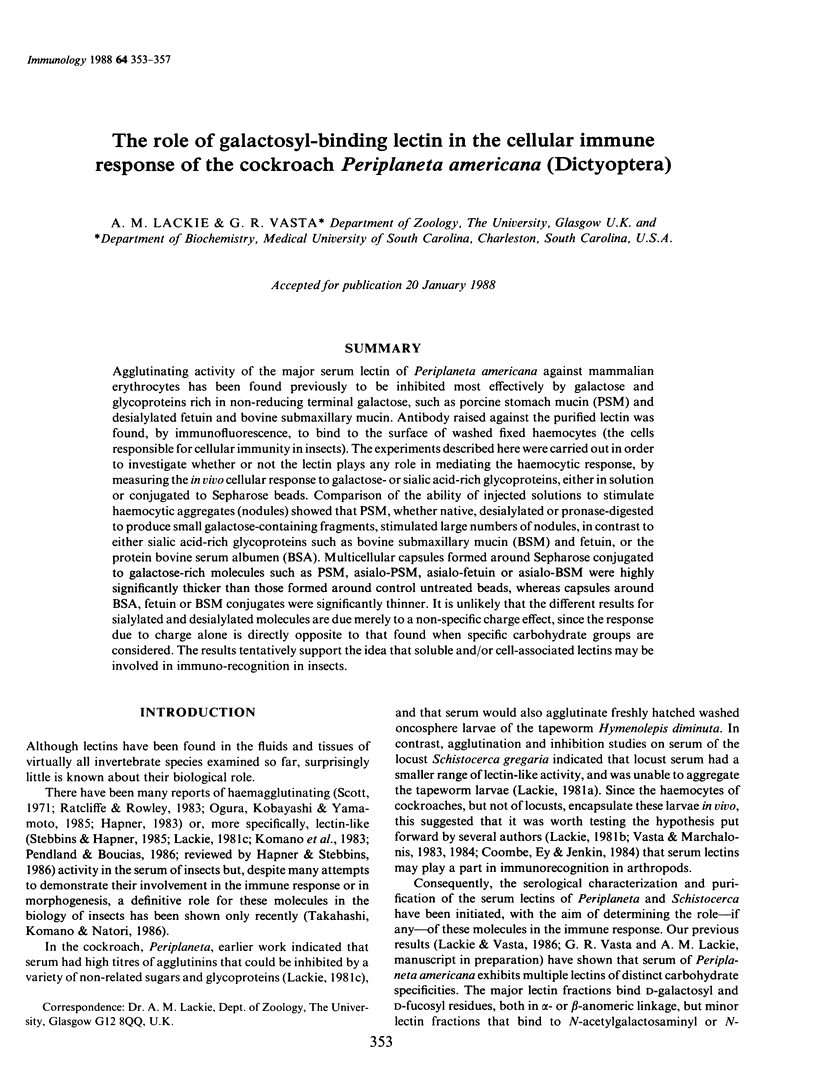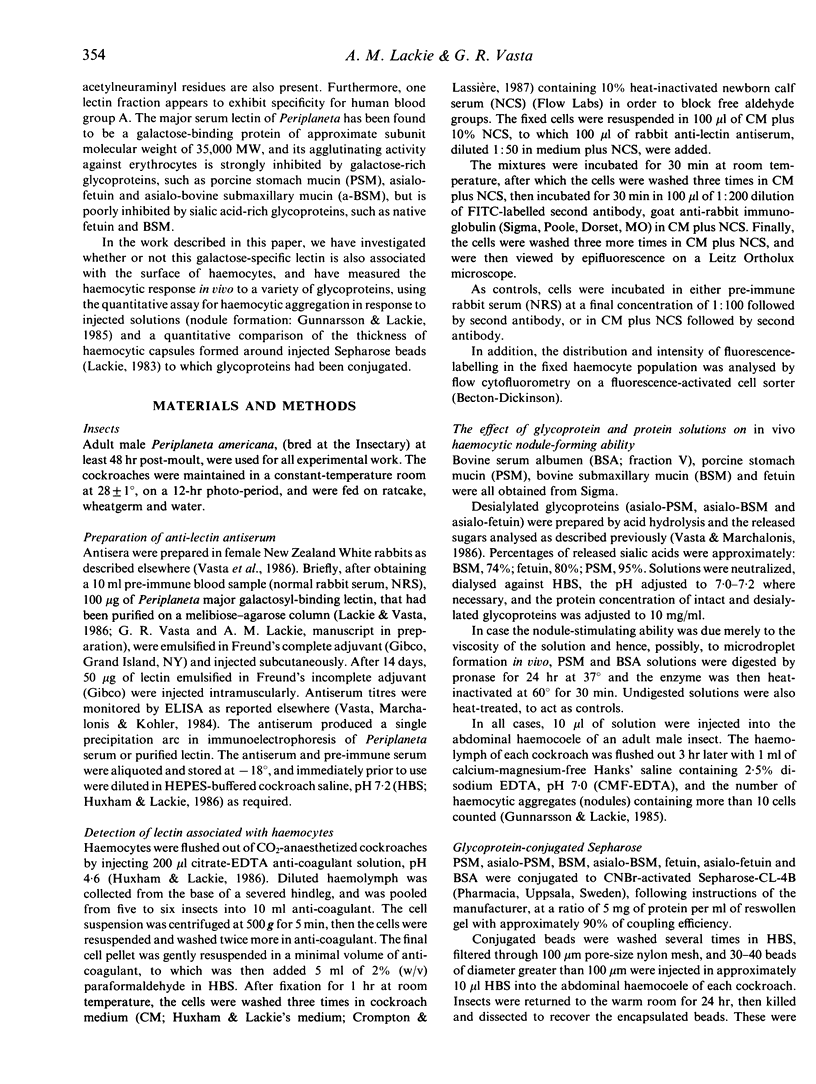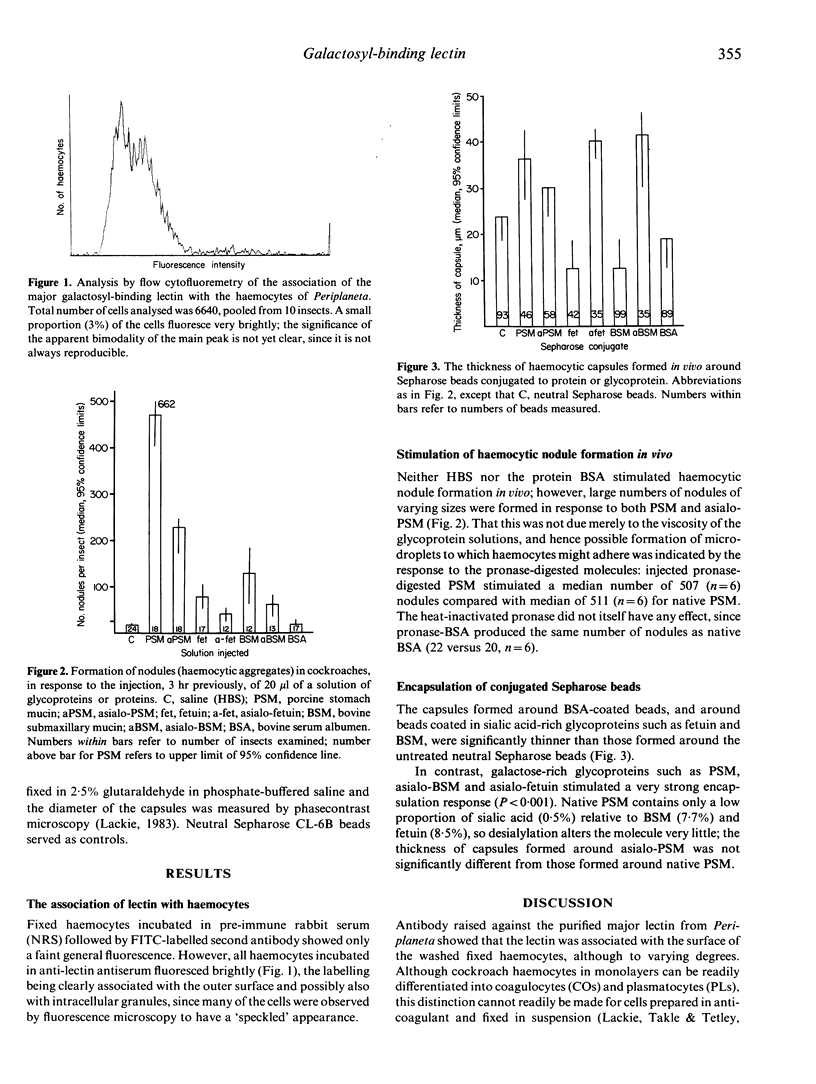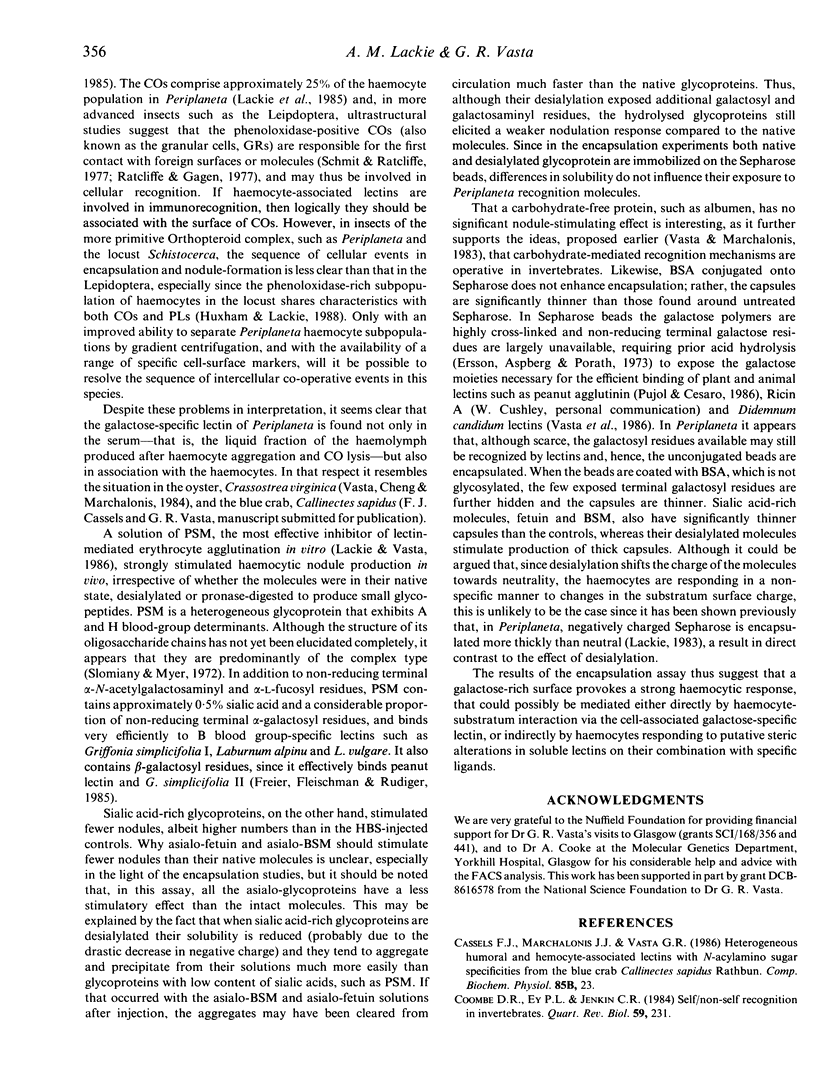Abstract
Agglutinating activity of the major serum lectin of Periplaneta americana against mammalian erythrocytes has been found previously to be inhibited most effectively by galactose and glycoproteins rich in non-reducing terminal galactose, such as porcine stomach mucin (PSM) and desialylated fetuin and bovine submaxillary mucin. Antibody raised against the purified lectin was found, by immunofluorescence, to bind to the surface of washed fixed haemocytes (the cells responsible for cellular immunity in insects). The experiments described here were carried out in order to investigate whether or not the lectin plays any role in mediating the haemocytic response, by measuring the in vivo cellular response to galactose- or sialic acid-rich glycoproteins, either in solution or conjugated to Sepharose beads. Comparison of the ability of injected solutions to stimulate haemocytic aggregates (nodules) showed that PSM, whether native, desialylated or pronase-digested to produce small galactose-containing fragments, stimulated large numbers of nodules, in contrast to either sialic acid-rich glycoproteins such as bovine submaxillary mucin (BSM) and fetuin, or the protein bovine serum albumen (BSA). Multicellular capsules formed around Sepharose conjugated to galactose-rich molecules such as PSM, asialo-PSM, asialo-fetuin or asialo-BSM were highly significantly thicker than those formed around control untreated beads, whereas capsules around BSA, fetuin or BSM conjugates were significantly thinner. It is unlikely that the different results for sialylated and desialylated molecules are due merely to a non-specific charge effect, since the response due to charge alone is directly opposite to that found when specific carbohydrate groups are considered. The results tentatively support the idea that soluble and/or cell-associated lectins may be involved in immuno-recognition in insects.
Full text
PDF




Selected References
These references are in PubMed. This may not be the complete list of references from this article.
- Cassels F. J., Marchalonis J. J., Vasta G. R. Heterogeneous humoral and hemocyte-associated lectins with N-acylaminosugar specificities from the blue crab, Callinectes sapidus Rathbun. Comp Biochem Physiol B. 1986;85(1):23–30. doi: 10.1016/0305-0491(86)90216-6. [DOI] [PubMed] [Google Scholar]
- Ersson B., Aspberg K., Porath J. The phytohemagglutinin from sunn hemp seeds (Crotalaria juncea). Purification by biospecific affinity chromatography. Biochim Biophys Acta. 1973 Jun 15;310(2):446–452. doi: 10.1016/0005-2795(73)90128-1. [DOI] [PubMed] [Google Scholar]
- Freier T., Fleischmann G., Rüdiger H. Affinity chromatography on immobilized hog gastric mucin and ovomucoid. A general method for isolation of lectins. Biol Chem Hoppe Seyler. 1985 Nov;366(11):1023–1028. doi: 10.1515/bchm3.1985.366.2.1023. [DOI] [PubMed] [Google Scholar]
- Komano H., Nozawa R., Mizuno D., Natori S. Measurement of Sarcophaga peregrina lectin under various physiological conditions by radioimmunoassay. J Biol Chem. 1983 Feb 25;258(4):2143–2147. [PubMed] [Google Scholar]
- Lackie A. M. Effect of substratum wettability and charge on adhesion in vitro and encapsulation in vivo by insect haemocytes. J Cell Sci. 1983 Sep;63:181–190. doi: 10.1242/jcs.63.1.181. [DOI] [PubMed] [Google Scholar]
- Lackie A. M. Immune recognition in insects. Dev Comp Immunol. 1981 Spring;5(2):191–204. doi: 10.1016/0145-305x(81)90027-6. [DOI] [PubMed] [Google Scholar]
- Pendland J. C., Boucias D. G. Characteristics of a galactose-binding hemagglutinin (lectin) from hemolymph of Spodoptera exigua larvae. Dev Comp Immunol. 1986 Fall;10(4):477–487. doi: 10.1016/0145-305x(86)90169-2. [DOI] [PubMed] [Google Scholar]
- Pujol F. H., Cesari I. M. A simplified methodology for purification of peanut (Arachis hypogaea) agglutinin. J Biochem Biophys Methods. 1986 Oct;13(3):131–134. doi: 10.1016/0165-022x(86)90085-0. [DOI] [PubMed] [Google Scholar]
- Ratcliffe N. A., Gagen S. J. Studies on the in vivo cellular reactions of insects: an ultrastructural analysis of nodule formation in Galleria mellonella. Tissue Cell. 1977;9(1):73–85. doi: 10.1016/0040-8166(77)90050-7. [DOI] [PubMed] [Google Scholar]
- Schmit A. R., Ratcliffe N. A. The encapsulation of foreign tissue implants in Galleria mellonella larvae. J Insect Physiol. 1977;23(2):175–184. doi: 10.1016/0022-1910(77)90027-0. [DOI] [PubMed] [Google Scholar]
- Slomiany B. L., Meyer K. Isolation and structural studies of sulfated glycoproteins of hog gastric mucosa. J Biol Chem. 1972 Aug 25;247(16):5062–5070. [PubMed] [Google Scholar]
- Vasta G. R., Cheng T. C., Marchalonis J. J. A lectin on the hemocyte membrane of the oyster (Crassostrea virginica). Cell Immunol. 1984 Oct 15;88(2):475–488. doi: 10.1016/0008-8749(84)90179-5. [DOI] [PubMed] [Google Scholar]
- Vasta G. R., Hunt J. C., Marchalonis J. J., Fish W. W. Galactosyl-binding lectins from the tunicate Didemnum candidum. Purification and physicochemical characterization. J Biol Chem. 1986 Jul 15;261(20):9174–9181. [PubMed] [Google Scholar]
- Vasta G. R., Marchalonis J. J. Galactosyl-binding lectins from the tunicate Didemnum candidum. Carbohydrate specificity and characterization of the combining site. J Biol Chem. 1986 Jul 15;261(20):9182–9186. [PubMed] [Google Scholar]
- Vasta G. R., Marchalonis J. J. Immunobiological significance of invertebrate lectins. Prog Clin Biol Res. 1984;157:177–191. [PubMed] [Google Scholar]
- Vasta G. R., Marchalonis J. J., Kohler H. Invertebrate recognition protein cross-reacts with an immunoglobulin idiotype. J Exp Med. 1984 Apr 1;159(4):1270–1276. doi: 10.1084/jem.159.4.1270. [DOI] [PMC free article] [PubMed] [Google Scholar]


